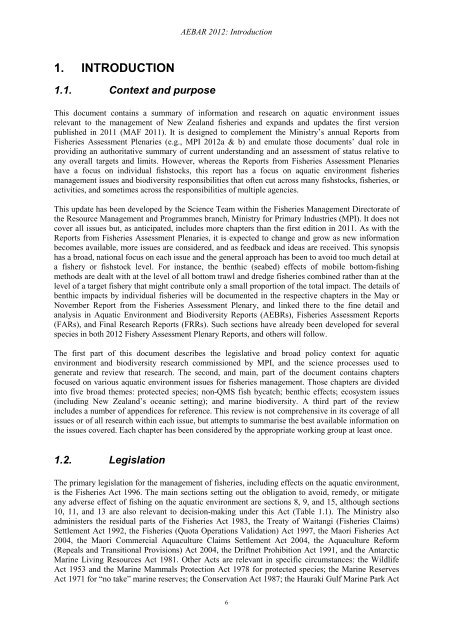Aquatic Environment and Biodiversity Annual Review 2012
Aquatic Environment and Biodiversity Annual Review 2012
Aquatic Environment and Biodiversity Annual Review 2012
Create successful ePaper yourself
Turn your PDF publications into a flip-book with our unique Google optimized e-Paper software.
1. INTRODUCTION<br />
1.1. Context <strong>and</strong> purpose<br />
AEBAR <strong>2012</strong>: Introduction<br />
This document contains a summary of information <strong>and</strong> research on aquatic environment issues<br />
relevant to the management of New Zeal<strong>and</strong> fisheries <strong>and</strong> exp<strong>and</strong>s <strong>and</strong> updates the first version<br />
published in 2011 (MAF 2011). It is designed to complement the Ministry’s annual Reports from<br />
Fisheries Assessment Plenaries (e.g., MPI <strong>2012</strong>a & b) <strong>and</strong> emulate those documents’ dual role in<br />
providing an authoritative summary of current underst<strong>and</strong>ing <strong>and</strong> an assessment of status relative to<br />
any overall targets <strong>and</strong> limits. However, whereas the Reports from Fisheries Assessment Plenaries<br />
have a focus on individual fishstocks, this report has a focus on aquatic environment fisheries<br />
management issues <strong>and</strong> biodiversity responsibilities that often cut across many fishstocks, fisheries, or<br />
activities, <strong>and</strong> sometimes across the responsibilities of multiple agencies.<br />
This update has been developed by the Science Team within the Fisheries Management Directorate of<br />
the Resource Management <strong>and</strong> Programmes branch, Ministry for Primary Industries (MPI). It does not<br />
cover all issues but, as anticipated, includes more chapters than the first edition in 2011. As with the<br />
Reports from Fisheries Assessment Plenaries, it is expected to change <strong>and</strong> grow as new information<br />
becomes available, more issues are considered, <strong>and</strong> as feedback <strong>and</strong> ideas are received. This synopsis<br />
has a broad, national focus on each issue <strong>and</strong> the general approach has been to avoid too much detail at<br />
a fishery or fishstock level. For instance, the benthic (seabed) effects of mobile bottom-fishing<br />
methods are dealt with at the level of all bottom trawl <strong>and</strong> dredge fisheries combined rather than at the<br />
level of a target fishery that might contribute only a small proportion of the total impact. The details of<br />
benthic impacts by individual fisheries will be documented in the respective chapters in the May or<br />
November Report from the Fisheries Assessment Plenary, <strong>and</strong> linked there to the fine detail <strong>and</strong><br />
analysis in <strong>Aquatic</strong> <strong>Environment</strong> <strong>and</strong> <strong>Biodiversity</strong> Reports (AEBRs), Fisheries Assessment Reports<br />
(FARs), <strong>and</strong> Final Research Reports (FRRs). Such sections have already been developed for several<br />
species in both <strong>2012</strong> Fishery Assessment Plenary Reports, <strong>and</strong> others will follow.<br />
The first part of this document describes the legislative <strong>and</strong> broad policy context for aquatic<br />
environment <strong>and</strong> biodiversity research commissioned by MPI, <strong>and</strong> the science processes used to<br />
generate <strong>and</strong> review that research. The second, <strong>and</strong> main, part of the document contains chapters<br />
focused on various aquatic environment issues for fisheries management. Those chapters are divided<br />
into five broad themes: protected species; non-QMS fish bycatch; benthic effects; ecosystem issues<br />
(including New Zeal<strong>and</strong>’s oceanic setting); <strong>and</strong> marine biodiversity. A third part of the review<br />
includes a number of appendices for reference. This review is not comprehensive in its coverage of all<br />
issues or of all research within each issue, but attempts to summarise the best available information on<br />
the issues covered. Each chapter has been considered by the appropriate working group at least once.<br />
1.2. Legislation<br />
The primary legislation for the management of fisheries, including effects on the aquatic environment,<br />
is the Fisheries Act 1996. The main sections setting out the obligation to avoid, remedy, or mitigate<br />
any adverse effect of fishing on the aquatic environment are sections 8, 9, <strong>and</strong> 15, although sections<br />
10, 11, <strong>and</strong> 13 are also relevant to decision-making under this Act (Table 1.1). The Ministry also<br />
administers the residual parts of the Fisheries Act 1983, the Treaty of Waitangi (Fisheries Claims)<br />
Settlement Act 1992, the Fisheries (Quota Operations Validation) Act 1997, the Maori Fisheries Act<br />
2004, the Maori Commercial Aquaculture Claims Settlement Act 2004, the Aquaculture Reform<br />
(Repeals <strong>and</strong> Transitional Provisions) Act 2004, the Driftnet Prohibition Act 1991, <strong>and</strong> the Antarctic<br />
Marine Living Resources Act 1981. Other Acts are relevant in specific circumstances: the Wildlife<br />
Act 1953 <strong>and</strong> the Marine Mammals Protection Act 1978 for protected species; the Marine Reserves<br />
Act 1971 for “no take” marine reserves; the Conservation Act 1987; the Hauraki Gulf Marine Park Act<br />
6

















